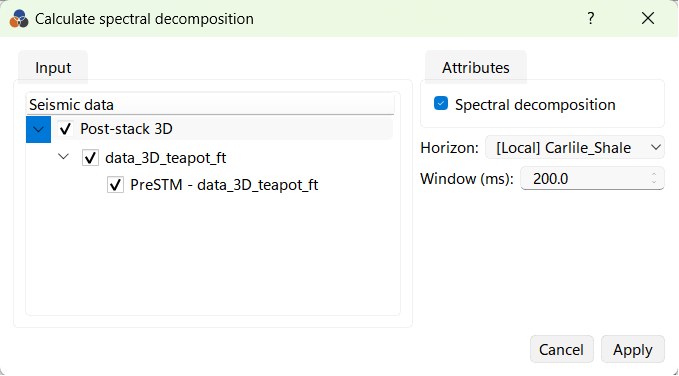Spectral decomposition is a technique in seismic interpretation used to analyze the frequency content of seismic data. By using spectral decomposition, we can visualize how different frequency bands respond to subsurface features, enhancing reservoir characterization.
How to Perform Spectral Decomposition
First, open the Attributes Bar where you can configure your spectral decomposition settings. From here, you’ll select the horizon or seismic data and the time window for which you want to perform the spectral decomposition.

g-Space offers three calculation Methods for spectral decomposition. Choose the one that fits your geological objectives. These methods vary in terms of how they handle time windows and frequency ranges, which may affect the resolution and interpretability of the results.
1. Short Window DFT (Discrete Fourier Transform)
The Short Window DFT method applies a fixed-length time window to the seismic trace and performs a Discrete Fourier Transform within that window. This approach offers a balance between time and frequency resolution but may lose precision for rapidly changing signals due to its fixed window size. Ideal for stable, continuous stratigraphy or thick-bedded sequences where uniform frequency content is expected over short intervals.
2. CWT (Continuous Wavelet Transform)
The CWT method uses wavelets of varying scales to analyze the seismic signal. Unlike DFT, the CWT provides a multi-resolution analysis by adapting the time window size to the frequency — wider for low frequencies and narrower for high frequencies. Best for resolving thin beds, complex stratigraphy, and fault zones where frequency content changes rapidly over short time periods.
3. S-Transform
The S-Transform combines elements of both the Short Window DFT and CWT. It uses a variable window length, similar to CWT, but retains a direct relationship with Fourier analysis. The S-Transform provides both good time and frequency localization, making it suitable for detecting frequency anomalies at different scales in complex geological environments. Effective for detecting tuning thickness, complex channel systems, and subtle reservoir heterogeneities due to its balance of time and frequency resolution.
Set Frequency and Window Parameters
After choosing your method, you need to set several key parameters:
•Taper Size (%): This controls how the edges of the time window are smoothed to avoid abrupt discontinuities that can distort the frequency analysis.
•Noise Level (%): This determines how much noise reduction will be applied during the decomposition process.
•Color Frequencies: Assign specific frequencies to each color (Red, Green, Blue) for visual blending. This helps to emphasize different frequency components in the final output.
•Min, Max, and Step Frequencies: Define the range and increment of frequencies analyzed. The Min frequency represents the lowest frequency to analyze, the Max frequency is the highest, and the Step frequency defines the intervals between frequency bands.
Once all parameters are set, click the Run Spectral Decomposition button at the Execute Tab in the Attributes Bar. In the subsequent window, select the seismic cubes you want to calculate, as well as the horizon and calculation window. When ready, click Apply to initiate the calculation.

After processing, a new map folder will appear in the Data Manager under the Maps folder. This map represents the spectral decomposition output and can be visualized on the location map. The method and the frequencies used in the calculation will be automatically written into the map name.

An example of a spectral decomposition map visualization is shown below. Users can customize the visualization in View Properties by adjusting the color palette and other available options.
